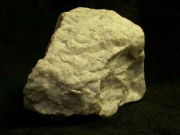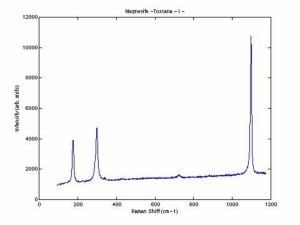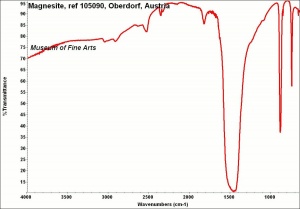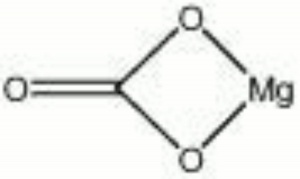Difference between revisions of "Magnesite, natural"
(username removed) |
|||
| Line 2: | Line 2: | ||
== Description == | == Description == | ||
| − | A naturally occurring mineral composed of [ | + | A naturally occurring mineral composed of [[magnesium%20carbonate|magnesium carbonate]] that is the primary commercial source of [[magnesium|magnesium]]. Magnesite deposits have been mined in Russia, Austria (Radenthein), Greece, Norway, India, China (Liaotung); Australia, Canada (Quebec) and the United States (Nevada, New Mexico, California, Alaska). The hexagonal mineral usually occurs in large masses. Magnesite can be transparent to opaque with colors of white, yellow, gray or pale brown due to the presence of impurities. Most magnesite is formed from the action of carbonated water on magnesium-rich ores. Powdered magnesite is used as a filler and inert pigment. Blocks of magnesite are used as a refractory material for furnace linings. Calcined magnesite is used in [[oxychloride%20cement|oxychloride cement]]. |
== Synonyms and Related Terms == | == Synonyms and Related Terms == | ||
Revision as of 09:17, 9 May 2014
Description
A naturally occurring mineral composed of Magnesium carbonate that is the primary commercial source of Magnesium. Magnesite deposits have been mined in Russia, Austria (Radenthein), Greece, Norway, India, China (Liaotung); Australia, Canada (Quebec) and the United States (Nevada, New Mexico, California, Alaska). The hexagonal mineral usually occurs in large masses. Magnesite can be transparent to opaque with colors of white, yellow, gray or pale brown due to the presence of impurities. Most magnesite is formed from the action of carbonated water on magnesium-rich ores. Powdered magnesite is used as a filler and inert pigment. Blocks of magnesite are used as a refractory material for furnace linings. Calcined magnesite is used in Oxychloride cement.
Synonyms and Related Terms
magnesia (incorrect); magnesia alba; magnesia white; Pigment White 18; magnesita (Esp.); magnésite (Fr.); Magnesit (Deut.); magnesiet (Ned.)
Other Properties
Hexagonal system with rhombohedral cleavage that is perfect in three directions.
Fracture = conchoidal. Luster = vitreous to silky. Streak = white.
Microscopically, particles appear as translucent, colorless, angular crystals. They exhibit high briefringence under crossed polars. Extinction is complete and straight.
| Composition | MgCO3 |
|---|---|
| CAS | 546-93-0 |
| Mohs Hardness | 3.5 - 4.5 |
| Density | 3.0-3.12 |
| Molecular Weight | mol. wt. = 84.3 |
| Refractive Index | 1.508; 1.510; 1.700 |
Hazards and Safety
Nontoxic. Ingestion has a laxative effect. Noncombustible.
International Chemical Safety Card
Additional Information
Mineralogy Database: Magnesite
Comparisons
Characteristics of Common White Pigments
Authority
- Helmut Schweppe, Schweppe color collection index and information book
- Nicholas Eastaugh, Valentine Walsh, Tracey Chaplin, Ruth Siddall, Pigment Compendium, Elsevier Butterworth-Heinemann, Oxford, 2004
- Ralph Mayer, A Dictionary of Art Terms and Techniques, Harper and Row Publishers, New York, 1969 (also 1945 printing)
- A.Lucas, J.R.Harris, Ancient Egyptian Materials and Industries, Edward Arnold Publishers Ltd., London, 4th edition, 1962
- Encyclopedia Britannica, http://www.britannica.com Comment: "magnesite" Encyclopædia Britannica [Accessed December 4, 2001].
- C.W.Chesterman, K.E.Lowe, Audubon Society Field Guide to North American Rocks and Minerals, Alfred A. Knopf, New York, 1979
- Wikipedia, the free encyclopedia, at http://www.wikipedia.com Comment: http://en.wikipedia.org/wiki/Magnesite (Accessed Sept. 7, 2005)
- Richard S. Lewis, Hawley's Condensed Chemical Dictionary, Van Nostrand Reinhold, New York, 10th ed., 1993
- Van Nostrand's Scientific Encyclopedia, Douglas M. Considine (ed.), Van Nostrand Reinhold, New York, 1976
- The American Heritage Dictionary or Encarta, via Microsoft Bookshelf 98, Microsoft Corp., 1998



